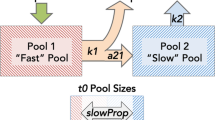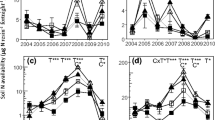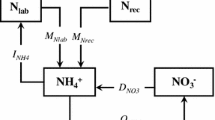Abstract
Characterization of the impacts of climate change on terrestrial carbon (C) cycling is important due to possible feedback mechanisms to atmospheric CO2 concentrations. We investigated soil organic matter (SOM) dynamics in the A1 and A2 horizons (~0–5.1 and ~5.1–12.3 cm depth, respectively) of a shrubland grass (Deschampsia flexuosa) after 8 years of exposure to: elevated CO2 (CO2), summer drought (D), warming (T) and all combinations hereof, with TDCO2 simulating environmental conditions for Denmark in 2075. The mean C residence time was highest in the heavy fraction (HF), followed by the occluded light fraction and the free light fraction (fLF), and it increased with soil depth, suggesting that C was stabilized on minerals at depth. A2 horizon SOM was susceptible to climate change whereas A1 horizon SOM was largely unaffected. The A2 horizon fLF and HF organic C stocks decreased by 43 and 23% in response to warming, respectively. Organic nitrogen (N) stocks of the A2 horizon fLF and HF decreased by 50 and 17%, respectively. Drought decreased the A2 horizon fLF N stock by 38%. Elevated CO2 decreased the A2 horizon fLF C stock by 39% and the fLF N stock by 50%. Under TDCO2, A2 horizon fLF C and N stocks decreased by 22 and 40%, respectively. Overall, our results indicate that shrubland SOM will be susceptible to increased turnover and associated net C and N losses in the future.




Similar content being viewed by others
References
Albert KR, Ro-Poulsen H, Mikkelsen TN, Michelsen A, Van der Linden L, Beier C (2011) Interactive effects of elevated CO2, warming, and drought on photosynthesis of Deschampsia flexuosa in a temperate heath ecosystem. J Exp Bot 62(12):4253–4266
Amundson RG, Davidson EA (1990) Carbon dioxide and nitrogenous gases in the soil atmosphere. J Geochem Explor 38(1–2):13–41
Andresen LC, Michelsen A, Jonasson S, Schmidt IK, Mikkelsen T, Ambus P, Beier C (2010) Plant nutrient mobilization in temperate heathland responds to elevated CO2, temperature and drought. Plant Soil 328(1):381–396
Arndal MF, Schmidt IK, Kongstad J, Beier C, Michelsen A (2013) Root growth and N dynamics in response to multi-year experimental warming, summer drought and elevated CO2 in a mixed heathland-grass ecosystem. Funct Plant Biol 42(1):1–10
Badeck FW, Tcherke G, Nogue S, Piel C, Ghashghaie J (2005) Post-photosynthetic fractionation of stable carbon isotopes between plant organs—a widespread phenomenon. Rapid Commun Mass Spectronom 19(11):1381–1391
Baisden WT, Amundson R, Cook AC, Brenner DL (2002) Turnover and storage of C and N in five density fractions from California annual grassland surface soils. Global Biogeochem Cy 16(4):1117–1132
Beare MH, Gregorich EG (2007) Physically uncomplexed organic matter. In: Carter MR, Gregoric EG (eds) Soil sampling and methods of analysis, 2nd edn. CRC Press, Boca Raton
Beier C, Emmett BA, Tietema A, Schmidt IK, Penuelas J, Kovács Láng E, Duce P, De Angelis P, Gorissen A, Estiarte M, de Dato D, Sowerby A, Kröel-Dulay G, Lellei-Kovács E, Kull O, Mand P, Petersen H, Gjelstrup P, Spano D, Estiarte M (2009) Carbon and nitrogen balances for six shrublands across Europe. Global Biogeochem Cy 23(4):1–13
Bimüller C, Dannenmann M, Tejedor J, von Lützow M, Buegger F, Meier R, Haug S, Schroll R, Kögel-Knabner I (2014) Prolonged summer droughts retard soil N processing and stabilization in organo-mineral fractions. Soil Biol Biochem 68:241–251
Bock M, Glaser B, Millar N (2007) Sequestration and turnover of plant- and microbially derived sugars in a temperate grassland soil during 7 years exposed to elevated atmospheric pCO2. Global Change Biol 13:478–490
Boesgaard K (2013) Long-term ecophysiological responses to climate change. Technical University of Denmark, Kgs Lyngby. http://orbit.dtu.dk/files/74245683/Thesis_FINAL_kboe.PDF
Bowden RD, Deemb L, Plantec AF, Peltre C, Nadelhoffer K, Lajtha K (2014) Litter input controls on soil carbon in a temperate deciduous forest. Soil Sci Soc Am J 78:S66–S75
Brunn M, Spielvogel S, Sauer T, Oelmann Y (2014) Temperature and precipitation effects on δ13C depth profiles in SOM under temperate beech forests. Geoderma 235–236:146–153
Buurman P, Roscoe R (2011) Different chemical composition of free light, occluded light and extractable SOM fractions in soils of Cerrado and tilled and untilled fields, Minas Gerais, Brazil: a pyrolysis-GC/MS study. Eur J Soil Sci 62:253–266
Carney K, Hungate B, Drake B, Megonigal J (2007) Altered soil microbial community at elevated CO2 leads to loss of soil carbon. Proc Natl Acad Sci USA 104(12):4990–4995
Carter MS, Ambus P, Albert K, Larsen KS, Anderson M, Prieme A, Van der Linden L, Beier C (2011) Effects of elevated atmospheric CO2, prolonged summer drought and temperature increase on N2O and CH4 fluxes in a temperate heathland. Soil Biol Biochem 43(8):1660–1670
Carter MS, Larsen KS, Emmett B, Estiarte M, Field C, Leith ID, Lund M, Meijide A, Mills RTE, Niinemets Ü, Peñuelas J, Portillo-Estrada M, Schmidt IK, Selsted MB, Sheppard LJ, Sowerby A, Tietema A, Beier C (2012) Synthesizing greenhouse gas fluxes across nine European peatlands and shrublands—responses to climatic and environmental changes. Biogeosciences 9:3739–3755
Christensen BT (2001) Physical fractionation of soil and structural and functional complexity in organic matter turnover. Eur J Soil Sci 52(3):345–353
Cotrofo MF, Gorissen A (1997) Elevated CO2 enhances below-ground C allocation in three perennial grass species at different levels of N availability. New Phytol 137:421–431
Cotrofo MF, Wallenstein MD, Boot CM, Denef K, Paul E (2013) The microbial efficiency-matrix stabilization (MEMS) framework integrates plant litter decomposition with soil organic matter stabilization: do labile plant inputs form stable soil organic matter? Global Change Biol 19(4):988–995
Davidson EA, Janssens IA (2006) Temperature sensitivity of soil carbon decomposition and feedbacks to climate change. Nature 440(9):165–173
Derrien D, Amelung W (2011) Computing the mean residence time of soil carbon fractions using stable isotopes: impacts of the model framework. Eur J Soil Sci 62:237–252
Dieleman WIJ, Vicca S, Dijkstra FA, Hagedorn F, Hovenden MJ, Larsen KS, Morgan JA, Volder A, Beier C, Dukes JS, King J, Leuzinger S, Linder S, Luo YQ, Oren R, de Angelis P, Tingey D, Hoosbeek MR, Janssens IA (2012) Simple additive effects are rare: a quantitative review of plant biomass and soil process responses to combined manipulations of CO2 and temperature. Global Change Biol 18(9):2681–2693
Follett RF, Stewart CE, Preuessner EG, Kimble JM (2012) Effects of climate change on soil carbon and nitrogen storage in the US Great Plains. J Soil Water Conserv 67(5):331–342
Garten C, Classen AT, Norby RJ (2009) Soil moisture surpasses elevated CO2 and temperature as a control on soil carbon dynamics in a multi-factor climate change experiment. Plant Soil 319(1):85–94
Gregorich EG, Beare MH, Mckim UF, Skjemstad JO (2006) Chemical and biological characteristics of physically uncomplexed organic matter. Soil Sci Soc Am J 70(3):975–985
Gunina A, Kuzyakov Y (2014) Pathways of litter C by formation of aggregates and SOM density fractions: implications from 13C natural abundance. Soil Biol Biochem 71:95–104
Gyldenkærne S, Münier B, Olsen J, Elsnab Olesen S, Petersen B, Christensen B (2005) Opgørelse af CO2-emissioner fra arealanvendelse og ændringer i arealanvendelse. Arbejdsrapport fra DMU, nr. 213. In. Danmarks Miljøundersøgelser. Miljøministeriet
Haugwitz MS, Bergmark L, Prieme A, Christensen S, Beier C, Michelsen A (2014) Soil microorganisms respond to five years of climate change manipulations and elevated atmospheric CO2 in a temperate heath ecosystem. Plant Soil 374:211–222
He Z, Xu M, Deng Y, Kang S, Kellogg L, Wu L, Van Nostrand J, Hobbie S, Reich P, Zhou J (2010) Metagenomic analysis reveals a marked divergence in the structure of belowground microbial communities at elevated CO2. Ecol Lett 13(5):564–575
Heimann M, Reichstein M (2008) Terrestrial ecosystem carbon dynamics and climate feedbacks. Nature 451(7176):289–292
Henry H, Juarez J, Field C, Vitousek P (2005) Interactive effects of elevated CO2, N deposition and climate change on extracellular enzyme activity and soil density fractionation in a California annual grassland. Global Change Biol 11(10):1808–1815
Hofmockel KS, Gallet-Budynek A, McCarthy HR, Currie WS, Jackson RB, Finzi A (2011a) Sources of increased N uptake in forest trees growing under elevated CO2: results of a large-scale 15N study. Global Change Biol 17:3338–3350
Hofmockel KS, Zak DR, Moran KK, Jastrow JD (2011b) Changes in forest soil organic matter pools after a decade of elevated CO2 and O3. Soil Biol Biochem 43(7):1518–1527
Hungate BA, Johnson DW, Dijkstra FA, Hymus G, Stiling P, Megonigal JP, Pagel AL, Moan JL, Day F, Li J, Hinkle R, Drake BG (2006) Nitrogen cycling during seven years of atmospheric CO2 enrichment in a shrub oak woodland. Ecology 87(1):26–40
IPCC (2013) Summary for Policymakers. In: Stocker TF, Qin D, Plattner G-K, Tignor M, Allen SK, Boschung J, Nauels A, Xia Y, Bex V and Midgle PM (eds) Climate change 2013: the physical science basis. Contribution of working group I to the fifth assessment report of the intergovernmental panel on climate change. Cambridge University Press, Cambridge
John B, Yamashita T, Ludwig B, Flessa H (2005) Storage of organic carbon in aggregate and density fractions of silty soils under different types of land use. Geoderma 128(1–2):63–79
Johnsen KH, Samuelson LJ, Sanchez FG, Eaton RJ (2013) Soil carbon and nitrogen content and stabilization in mid-rotation, intensively managed sweetgum and loblolly pine stands. Forest Ecol Manag 302:144–153
Juo ASR, Franzluebbers K (2003) Tropical soils. Properties and management for sustainable agriculture. Oxford University Press, New York
Kleber M, Sollins P, Sutton R (2007) A conceptual model of organo-mineral interactions in soils: self-assembly of organic molecular fragments into zonal structures on mineral surfaces. Biogeochemistry 85(1):9–24
Kogel-Knabner I, Guggenberger G, Kleber M, Kandeler E, Kalbitz K, Scheu S, Eusterhues K, Leinweber P (2008) Organo-mineral associations in temperate soils: integrating biology, mineralogy, and organic matter chemistry. J Plant Nutr Soil Sci 171(1):61–82
Kongstad J, Schmidt IK, Riis-Nielsen T, Arndal MF, Mikkelsen TN, Beier C (2012) High resilience in heathland plants to changes in temperature, drought, and CO2 in combination: results from the CLIMAITE experiment. Ecosystems 15(2):269–283
Kotroczo Z, Fekete I, Toth JA, Tothmeresz B, Balazsy S (2008) Effect of leaf- and root-litter manipulation for carbon-dioxide efflux in forest soil. Cereal Res Commun 36:663–666
Kröel-Dulay G, Ransijn J, Schmidt IK, Beier C, De Angelis P, de Dato G, Dukes JS, Emmett B, Estiarte M, Garadnai J, Kongstad J, Kovacs-Lang E, Larsen KS, Liberati D, Ogaya R, Riis-Nielsen T, Smith AR, Sowerby A, Tietema A, Penuelas J (2015) Increased sensitivity to climate change in disturbed ecosystems. Nat Commun 6:1–6
Larsen KS, Andresen LC, Beier C, Jonasson S, Albert KR, Ambus P, Arndal MF, Carter MS, Christensen S, Holmstrup M, Ibrom A, Kongstad J, van der Linden L, Maraldo K, Michelsen A, Mikkelsen TN, Pilegaard K, Prieme A, Ro-Poulsen H, Schmidt IK, Selsted MB, Stevnbak K (2011) Reduced N cycling in response to elevated CO2, warming, and drought in a Danish heathland: synthesizing results of the CLIMAITE project after two years of treatments. Global Change Biol 17(5):1884–1899
Leifeld J, Bassin S, Conen F, Hajdas I, Egli M, Fuhrer J (2013) Control of soil pH on turnover of belowground organic matter in subalpine grassland. Biogeochemistry 112:59–69
Linn DM, Doran JW (1984) Effect of water-filled pore space on carbon dioxide and nitrous oxide production in tilled and nontilled soils. Soil Sci Soc Am J 48:1268–1272
Luo Y, Sherry R, Zhou X, Wan S (2009) Terrestrial carbon-cycle feedback to climate warming: experimental evidence on plant regulation and impacts of biofuel feedstock harvest. Global Change Biol 1(1):62–74
Maraldo K, Krogh PH, van der Linden L, Christensen BT, Mikkelsen TN, Beier C, Holmstrup M (2010) The counteracting effects of elevated atmospheric CO2 concentrations and drought episodes: studies of enchytraeid communities in a dry heathland. Soil Biol Biochem 42(11):1958–1966
Marschner B, Brodowski S, Dreves A, Gleixner G, Gude A, Grootes PM, Hamer U, Heim A, Jandl G, Ji R, Kaiser K, Kalbitz K, Kramer C, Leinweber P, Rethemeyer J, Schäffer A, Schmidt MWI, Schwark L, Wiesenberg GLB (2008) How relevant is recalcitrance for the stabilization of organic matter. J Plant Nutr Soil Sci 171:91–110
Mehrabanian M (2013) Molecular geochemistry of soil organic matter by pyrolysis gas chromatography/mass spectrometry (GC/MS) technique: a review. J Soil Sci Environ Manag 4(2):11–16
Meyer S, Leifeild J (2013) Concurrent increase in 15N and radiocarbon age in soil density fractions. J Plant Nutr Soil Sci 176:505–508
Mikkelsen TN, Beier C, Holmstrup M, Schmidt IK, Ambus P, Pilegaard K, Michelsen A, Albert K, Andresen LC, Arndal MF, Bruun N, Christensen S, Danbæk S, Gundersen P, Jørgensen P, Linden LG, Kongstad J, Maraldo K, Priemé A, Riis-Nielsen T, Ro-Poulsen H, Stevnbak K, Selsted MB, Sørensen P, Larsen KS, Carter MS, Ibrom A, Martinussen T, Miglietta F, Sverdrup H (2008) Experimental design of multifactor climate change experiments with elevated CO2, warming and drought: the CLIMAITE project. Funct Ecol 22:185–195
Mikutta R, Kleber M, Torn MS, Jahn R (2006) Stabilization of soil organic matter: association with minerals or chemical recalcitrance? Biogeochemistry 77:25–56
Munné Bosch S (2004) Die and let live: leaf senescence contributes to plant survival under drought stress. Funct Plant Biol 31(3):203–216
Nie M, Pendall E, Bell C, Wallenstein MD (2014) Soil aggregate size distribution mediates microbial climate change feedbacks. Soil Biol Biochem 68:357–365
Ostrowska A, Porębska G (2012) Assement of TOC-SOM and SOM-TOC conversion in forest soil. Proc J Environ Stud 21(6):1767–1775
Park R, Epstein S (1961) Metabolic fractionation of C13 and C12 in plants. Plant Physiol 36(2):133–138
Poirier N, Derenne S, Balesdent J, Mariotti A, Massiot D, Largeau C (2003) Isolation and analysis of the non-hydrolysable fraction of a forest soil and an arable soil (Lacadee, southwest France). Eur J Soil Sci 54(2):243–255
R Core Team (2014) R: A language and environment for statistical computing. In. R Foundation for statistical computing, Vienna, Austria
Raab GA, Bartling MH, Stapanian MA, Cole WH, Tidwell RL, Cappo KA (1990) The homogenization of environmental soil samples in bulk. In: Simmons MS (ed) Hazardous waste measurements. CRC Press, Boca Raton
Reinsch S, Ambus P (2013) In situ 13CO2 pulse-labeling in a temperate heathland—development of a mobile multi-plot field setup. Rapid Commun Mass Spectronom 27:1417–1428
Roscoe R, Buurman P, van Lagen B, Velhorst E (2004) Transformation in occluded light fraction organic matter in a clayey oxisol; evidence from 13C-CPMAS-NMR and d13C signature. Rev Bras Cienc Solo 28:811–818
Scherber C, Gladbach DJ, Stevnbak K, Karsten RJ, Schmidt IK, Michelsen A, Albert KR, Larsen KS, Mikkelsen TN, Beier C, Christensen S (2013) Multi-factor climate change effects on insect herbivore performance. Ecol Evol 3(6):1449–1460
Schlesinger WH, Reynolds JF, Cunningham GL, Huenneke LF, Jarrel WM, Virginia RA, Whitford WG (1990) Biological feedbacks in global desertification. Sci Total Environ 247(4946):1043–1048
Schmidt MWI, Rumpel C, Kogel-Knabner I (1999) Evaluation of an ultrasonic dispersion procedure to isolate primary organomineral complexes from soils. Eur J Soil Sci 50(1):87–94
Schnitzer M, Khan SU (1978) Soil organic matter. Developments in soil science 8. Elsevier, Amsterdam
Schrumpf M, Kaiser K, Guggenberger G, Persson T, Kogel-Knabner I, Schulze ED (2013) Storage and stability of organic carbon in soils as related to depth, occlusion within aggregates, and attachment to minerals. Biogeosciences 10(3):1675–1691
Selsted MB, van der Linden L, Ibrom A, Michelsen A, Larsen KS, Pedersen JK, Mikkelsen T, Pilegaard K, Beier C, Ambus P (2012) Soil respiration is stimulated by elevated CO2 and reduced by summer drought: three years of measurements in a multifactor ecosystem manipulation experiment in a temperate heathland (CLIMAITE). Global Change Biol 18:1216–1230
Skopp J, Jawson MD, Doran JW (1990) Steady-state aerobic microbial activity as a function of soil water content. Soil Sci Soc Am J 54(6):1619–1625
Suseela V, Tharayil N, Xing B, Dukes JS (2013) Labile compounds in plant litter reduced the sensitivity of decomposition to warming and altered precipitation. New Phytol 200:122–133
Suttle KB, Thomsen MA, Power ME (2007) Species interactions reverse grassland responses to changing climate. Science 315(5812):6640–6642
Thockmorton HM, Bird JA, Dane L, Firestone MK, Horwarth WR (2012) The source of microbial C has little impact on soil organic matter stabilisation in forest ecosystems. Ecol Lett 15:1257–1265
Trumbore SE, Czimczik CI (2008) Geology—an uncertain future for soil carbon. Science 321(5895):1455–1456
Van Groenigen K, Qi X, Osenberg C, Luo Y, Hungate B (2014) Faster decomposition under increased atmospheric CO2 limits soil carbon storage. Science 344(6183):508–509
Wagai R, Mayer LM, Kitayama K (2009) Nature of the “occluded” low-density fraction in soil organic matter studies: a critical review. Soil Sci Plant Nutr 55(1):13–25
Welch BL (1947) The generalization of “Student’s” problem when several different population variances are involved. Biometrika 34(1–2):28–35
Xu M, Lou Y, Sun X, Wang W, Baniyamuddin M, Zhao K (2011) Soil organic carbon active fractions as early indicators for total carbon change under straw incorporation. Biol Fert Soils 47:745–752
Acknowledgements
The authors thank Nina Thomsen, Mette Flodgaard and Anja Nielsen for skilled technical and laboratory support. Professor Bent T. Christensen at Aarhus University, Denmark, provided competent guidance on initial methodology test trials. Stina Rasmussen and Henrik Breuning-Madsen at the University of Copenhagen are thanked for contributing with the textural analysis of the studied soil. The CLIMAITE experiment is financially supported by the Villum Kann Rasmussen Foundation with co-funding from Air Liquide, DONG Energy and SMC Pneumatic A/S.
Author information
Authors and Affiliations
Corresponding author
Additional information
Responsible Editor: Edward Brzostek.
Electronic supplementary material
Below is the link to the electronic supplementary material.
Rights and permissions
About this article
Cite this article
Thaysen, E.M., Reinsch, S., Larsen, K.S. et al. Decrease in heathland soil labile organic carbon under future atmospheric and climatic conditions. Biogeochemistry 133, 17–36 (2017). https://doi.org/10.1007/s10533-017-0303-3
Received:
Accepted:
Published:
Issue Date:
DOI: https://doi.org/10.1007/s10533-017-0303-3




